Abstract
Two commercial automated, non-invasive systems for estimation of cardiac output were evaluated. Values of cardiac output obtained by electrical bioimpedance cardiography (BoMed NCCOM3 machine) were compared with values derived from an indirect Fick technique that uses carbon dioxide rebreathing (Gould 9000 IV system) during 103 simultaneous measurements made at rest in 19 randomly selected subjects and on exercise in 11 subjects. Cardiac output values obtained with impedance cardiography were significantly correlated with those measured by the indirect Fick method, although there was a wide scatter with over 73% of the readings lying outside the limits defined by the line of identity +/- 20%. This correlation was greatly reduced when stroke volume index was used instead of cardiac output. Indirect Fick results were linearly related to oxygen uptake both at rest and on exercise, while impedance cardiography results did not correlate with oxygen uptake. Impedance cardiography gave consistently lower results for cardiac output than indirect Fick at all levels of exercise. Both machines were easy to use and produced acceptable mean (SE) coefficients of variation (BoMed NCCOM3 7.7 (1.0)%, Gould 9000 IV 10.6 (1.4)%). Further validation is required before either of these machines can be recommended as an alternative to invasive monitoring in clinical practice.
Full text
PDF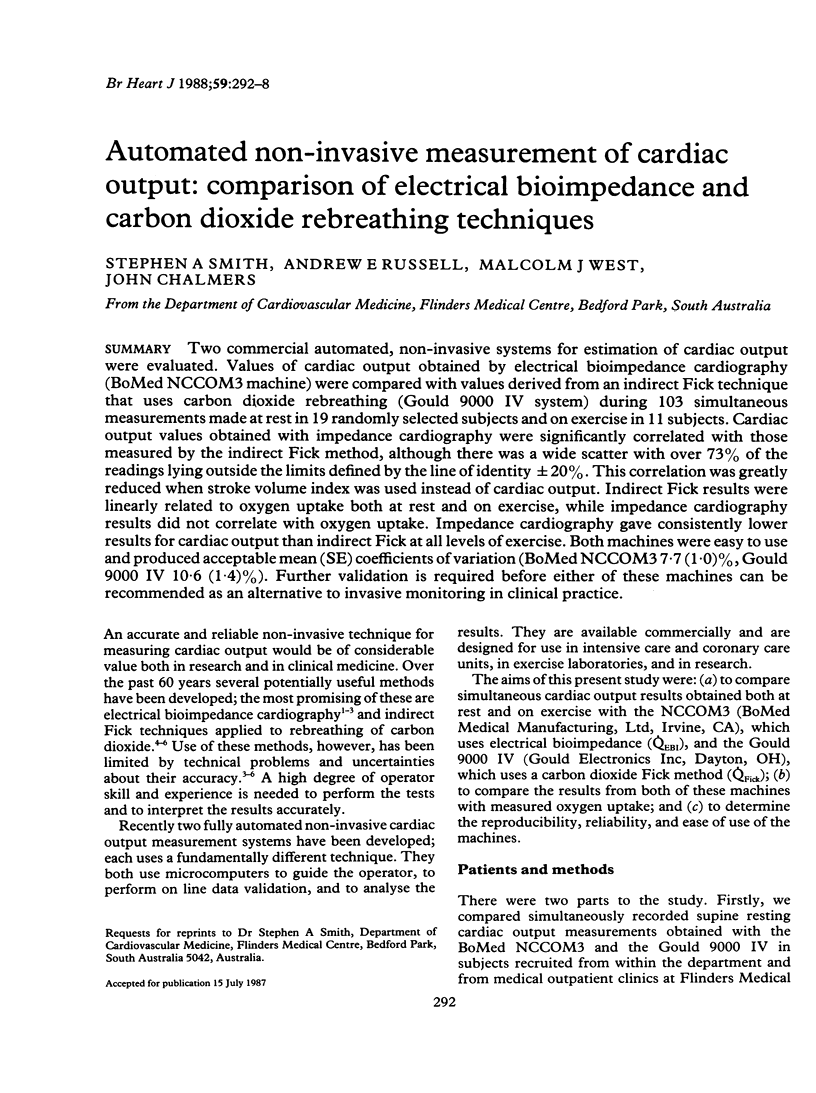
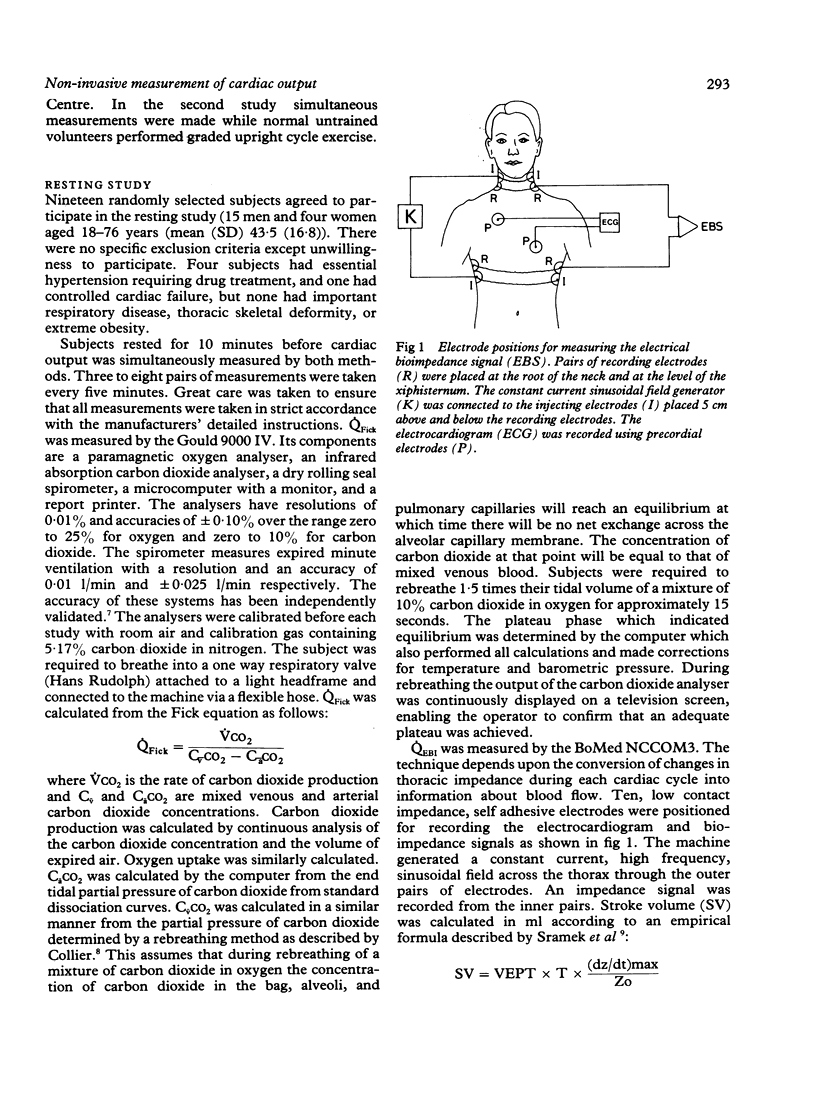
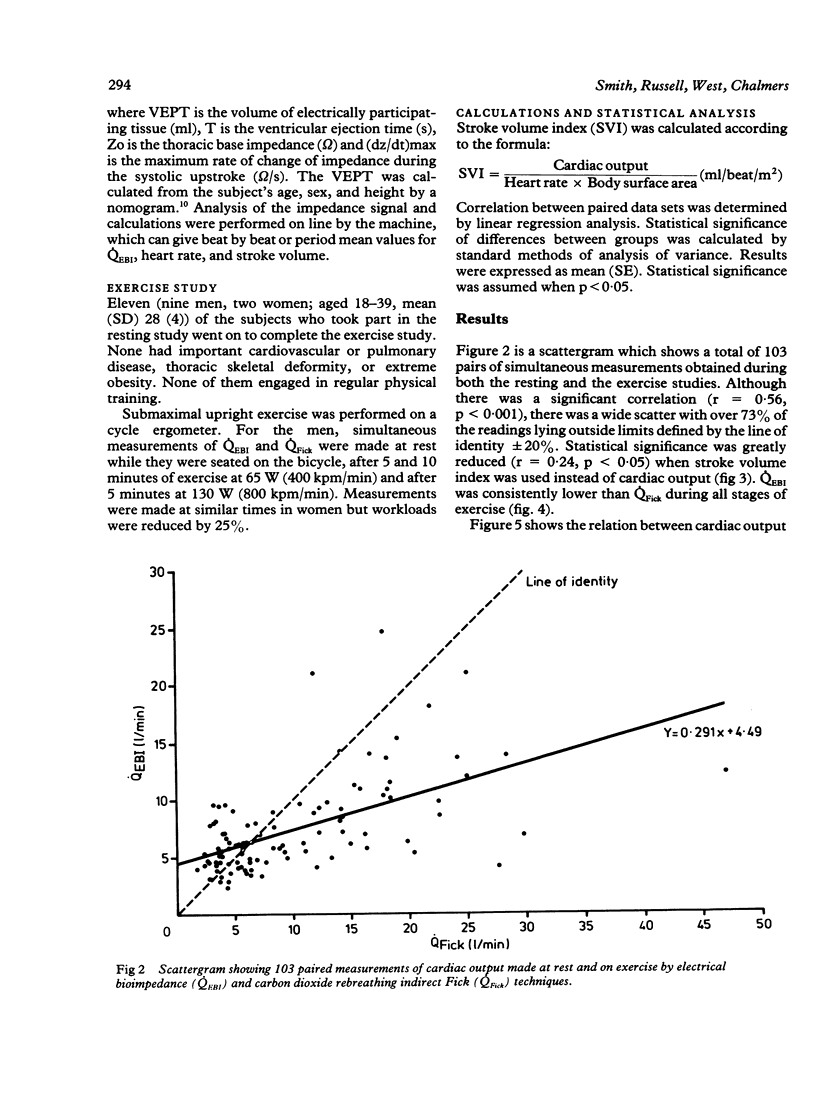
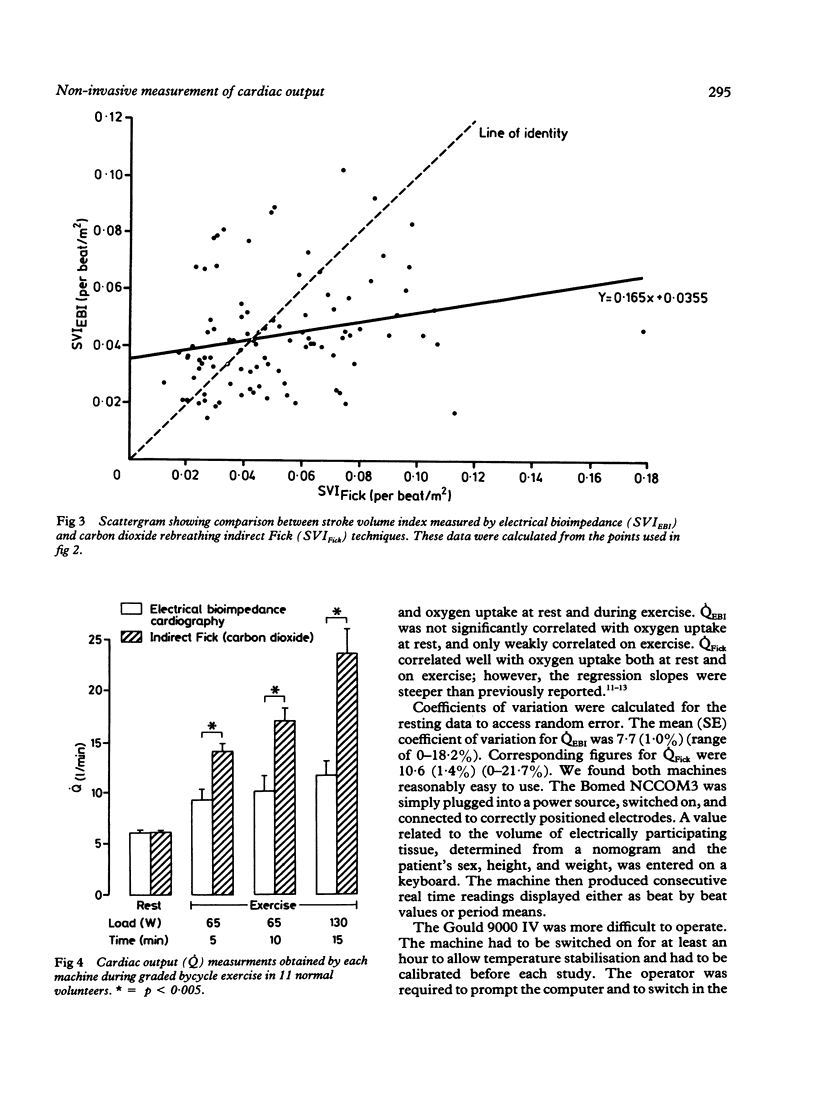
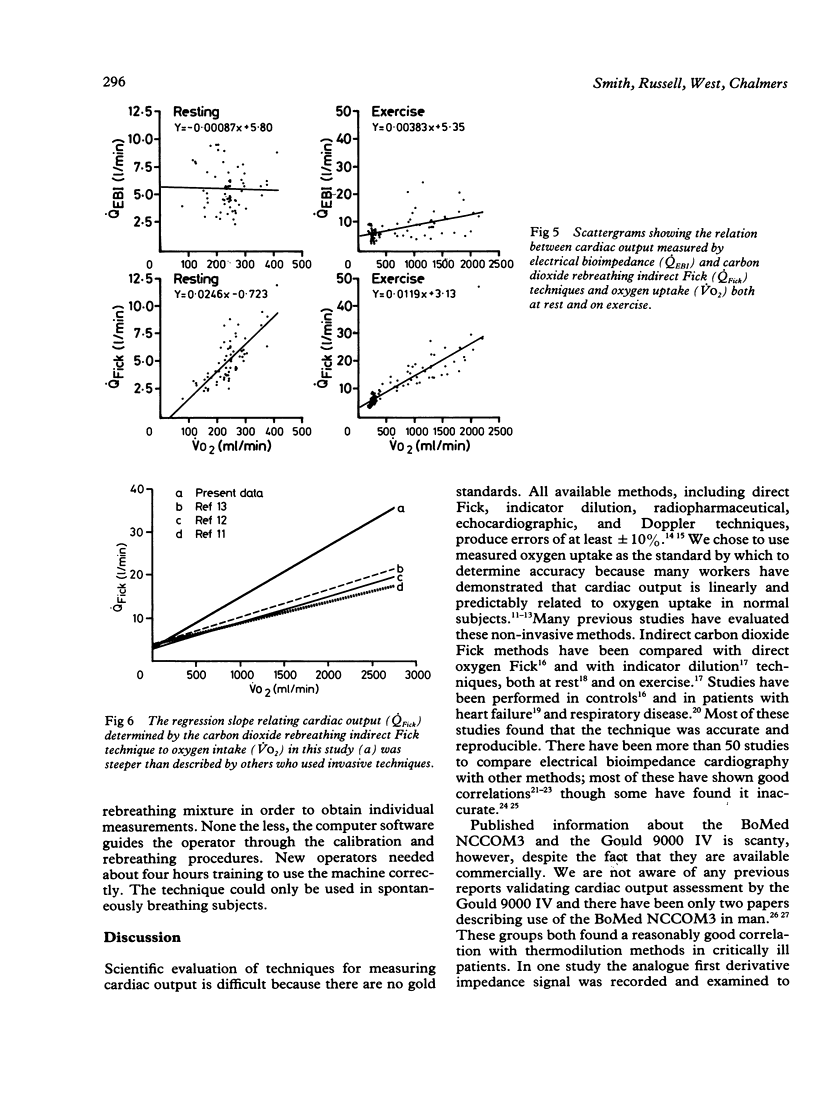
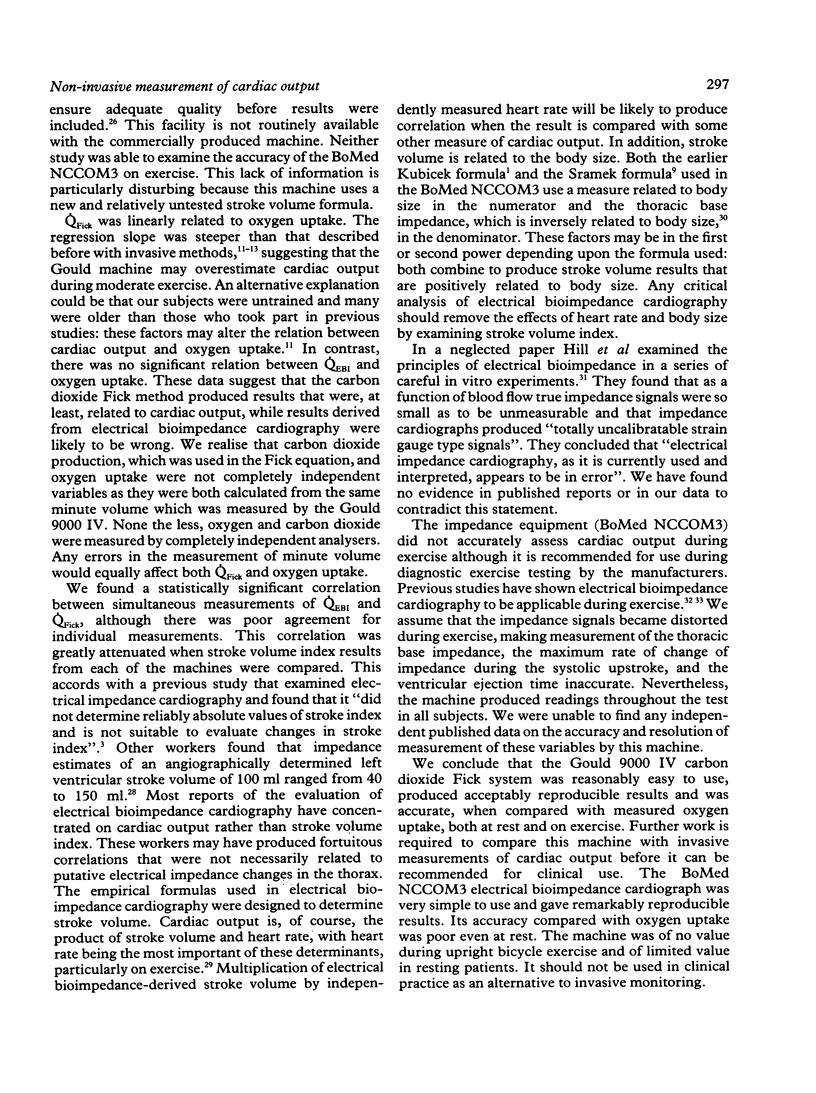
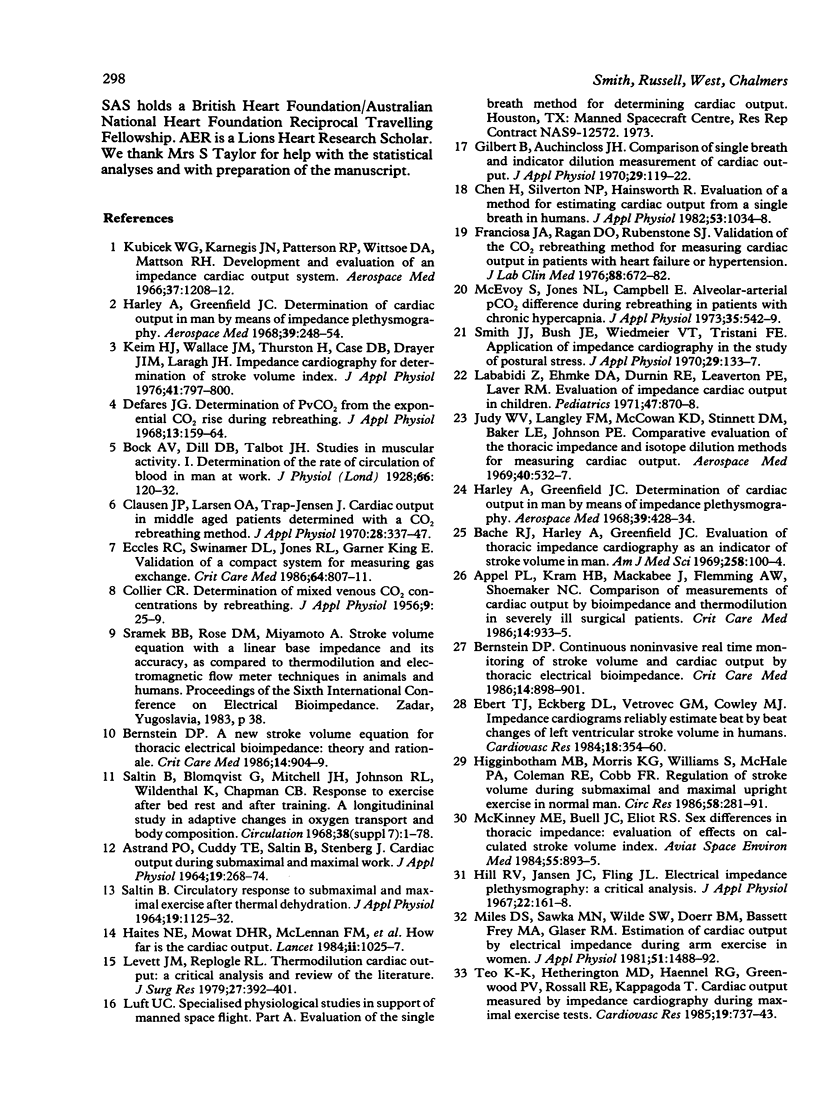
Selected References
These references are in PubMed. This may not be the complete list of references from this article.
- ASTRAND P. O., CUDDY T. E., SALTIN B., STENBERG J. CARDIAC OUTPUT DURING SUBMAXIMAL AND MAXIMAL WORK. J Appl Physiol. 1964 Mar;19:268–274. doi: 10.1152/jappl.1964.19.2.268. [DOI] [PubMed] [Google Scholar]
- Appel P. L., Kram H. B., Mackabee J., Fleming A. W., Shoemaker W. C. Comparison of measurements of cardiac output by bioimpedance and thermodilution in severely ill surgical patients. Crit Care Med. 1986 Nov;14(11):933–935. doi: 10.1097/00003246-198611000-00004. [DOI] [PubMed] [Google Scholar]
- Bache R. J., Harley A., Greenfield J. C., Jr Evaluation of thoracic impedance plethysmography as an indicator of stroke volume in man. Am J Med Sci. 1969 Aug;258(2):100–113. doi: 10.1097/00000441-196908000-00006. [DOI] [PubMed] [Google Scholar]
- Bernstein D. P. A new stroke volume equation for thoracic electrical bioimpedance: theory and rationale. Crit Care Med. 1986 Oct;14(10):904–909. doi: 10.1097/00003246-198610000-00017. [DOI] [PubMed] [Google Scholar]
- Bernstein D. P. Continuous noninvasive real-time monitoring of stroke volume and cardiac output by thoracic electrical bioimpedance. Crit Care Med. 1986 Oct;14(10):898–901. doi: 10.1097/00003246-198610000-00015. [DOI] [PubMed] [Google Scholar]
- COLLIER C. R. Determination of mixed venous CO2 tensions by rebreathing. J Appl Physiol. 1956 Jul;9(1):25–29. doi: 10.1152/jappl.1956.9.1.25. [DOI] [PubMed] [Google Scholar]
- Chen H., Silverton N. P., Hainsworth R. Evaluation of a method for estimating cardiac output from a single breath in humans. J Appl Physiol Respir Environ Exerc Physiol. 1982 Oct;53(4):1034–1038. doi: 10.1152/jappl.1982.53.4.1034. [DOI] [PubMed] [Google Scholar]
- Clausen J. P., Larsen O. A., Trap-Jensen J. Cardiac output in middle-aged patients determined with CO2 rebreathing method. J Appl Physiol. 1970 Mar;28(3):337–342. doi: 10.1152/jappl.1970.28.3.337. [DOI] [PubMed] [Google Scholar]
- DEFARES J. G. Determination of PvCO2 from the exponential CO2 rise during rebreathing. J Appl Physiol. 1958 Sep;13(2):159–164. doi: 10.1152/jappl.1958.13.2.159. [DOI] [PubMed] [Google Scholar]
- Ebert T. J., Eckberg D. L., Vetrovec G. M., Cowley M. J. Impedance cardiograms reliably estimate beat-by-beat changes of left ventricular stroke volume in humans. Cardiovasc Res. 1984 Jun;18(6):354–360. doi: 10.1093/cvr/18.6.354. [DOI] [PubMed] [Google Scholar]
- Eccles R. C., Swinamer D. L., Jones R. L., King E. G. Validation of a compact system for measuring gas exchange. Crit Care Med. 1986 Sep;14(9):807–811. doi: 10.1097/00003246-198609000-00010. [DOI] [PubMed] [Google Scholar]
- Franciosa J. A., Ragan D. O., Rubenstone S. J. Validation of the CO2 rebreathing method for measuring cardiac output in patients with hypertension or heart failure. J Lab Clin Med. 1976 Oct;88(4):672–682. [PubMed] [Google Scholar]
- Gilbert R., Auchincloss J. H., Jr Comparison of single-breath and indicator-dilution measurement of cardiac output. J Appl Physiol. 1970 Jul;29(1):119–122. doi: 10.1152/jappl.1970.29.1.119. [DOI] [PubMed] [Google Scholar]
- Haites N. E., McLennan F. M., Mowat D. H., Rawles J. M. How far is the cardiac output? Lancet. 1984 Nov 3;2(8410):1025–1027. doi: 10.1016/s0140-6736(84)91118-8. [DOI] [PubMed] [Google Scholar]
- Harley A., Greenfield J. C., Jr Determination of cardiac output in man by means of impedance plethysmography. Aerosp Med. 1968 Mar;39(3):248–252. [PubMed] [Google Scholar]
- Higginbotham M. B., Morris K. G., Williams R. S., McHale P. A., Coleman R. E., Cobb F. R. Regulation of stroke volume during submaximal and maximal upright exercise in normal man. Circ Res. 1986 Feb;58(2):281–291. doi: 10.1161/01.res.58.2.281. [DOI] [PubMed] [Google Scholar]
- Hill R. V., Jansen J. C., Fling J. L. Electrical impedance plethysmography: a critical analysis. J Appl Physiol. 1967 Jan;22(1):161–168. doi: 10.1152/jappl.1967.22.1.161. [DOI] [PubMed] [Google Scholar]
- Judy W. V., Langley F. M., McCowen K. D., Stinnett D. M., Baker L. E., Johnson P. C. Comparative evaluation of the thoracic impedance and isotope dilution methods for measuring cardiac output. Aerosp Med. 1969 May;40(5):532–536. [PubMed] [Google Scholar]
- Keim H. J., Wallace J. M., Thurston H., Case D. B., Drayer J. I., Laragh J. H. Impedance cardiography for determination of stroke index. J Appl Physiol. 1976 Nov;41(5 Pt 1):797–799. doi: 10.1152/jappl.1976.41.5.797. [DOI] [PubMed] [Google Scholar]
- Kubicek W. G., Karnegis J. N., Patterson R. P., Witsoe D. A., Mattson R. H. Development and evaluation of an impedance cardiac output system. Aerosp Med. 1966 Dec;37(12):1208–1212. [PubMed] [Google Scholar]
- Lababidi Z., Ehmke D. A., Durnin R. E., Leaverton P. E., Lauer R. M. Evaluation of impedance cardiac output in children. Pediatrics. 1971 May;47(5):870–879. [PubMed] [Google Scholar]
- Levett J. M., Replogle R. L. Thermodilution cardiac output: a critical analysis and review of the literature. J Surg Res. 1979 Dec;27(6):392–404. doi: 10.1016/0022-4804(79)90159-8. [DOI] [PubMed] [Google Scholar]
- McEvoy J. D., Jones N. L., Campbell E. J. Alveolar-arterial PCO2 difference during rebreathing in patients with chronic hypercapnia. J Appl Physiol. 1973 Oct;35(4):542–545. doi: 10.1152/jappl.1973.35.4.542. [DOI] [PubMed] [Google Scholar]
- McKinney M. E., Buell J. C., Eliot R. S. Sex differences in transthoracic impedance: evaluation of effects on calculated stroke volume index. Aviat Space Environ Med. 1984 Oct;55(10):893–895. [PubMed] [Google Scholar]
- Miles D. S., Sawka M. N., Wilde S. W., Doerr B. M., Frey M. A., Glaser R. M. Estimation of cardiac output by electrical impedance during arm exercise in women. J Appl Physiol Respir Environ Exerc Physiol. 1981 Dec;51(6):1488–1492. doi: 10.1152/jappl.1981.51.6.1488. [DOI] [PubMed] [Google Scholar]
- SALTIN B. CIRCULATORY RESPONSE TO SUBMAXIMAL AND MAXIMAL EXERCISE AFTER THERMAL DEHYDRATION. J Appl Physiol. 1964 Nov;19:1125–1132. doi: 10.1152/jappl.1964.19.6.1125. [DOI] [PubMed] [Google Scholar]
- Smith J. J., Bush J. E., Wiedmeier V. T., Tristani F. E. Application of impedance cardiography to study of postural stress. J Appl Physiol. 1970 Jul;29(1):133–137. doi: 10.1152/jappl.1970.29.1.133. [DOI] [PubMed] [Google Scholar]
- Teo K. K., Hetherington M. D., Haennel R. G., Greenwood P. V., Rossall R. E., Kappagoda T. Cardiac output measured by impedance cardiography during maximal exercise tests. Cardiovasc Res. 1985 Dec;19(12):737–743. doi: 10.1093/cvr/19.12.737. [DOI] [PubMed] [Google Scholar]
- Toliver W. H., Sr, Hoffman P. E. Liquid crystals--a new biomedical research area. Aerosp Med. 1968 Apr;39(4):428–428. [PubMed] [Google Scholar]


